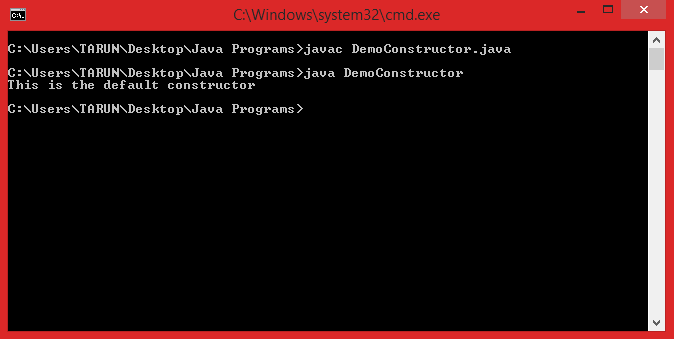Definition of Constructor :
A Constructor is used to initialize an object
immediately upon creation. It has the same name as that of a class in which it
resides and is syntactically similar to a method.
A constructor has no return
type, not even void. This is because the implicit return type of a class’
constructor is the class type itself.
Why we need Constructors ?
Whenever we write a program, it can be tedious
to initialize all of the variables in a class each time an instance is created.
It would be simpler and more concise to have all of the setup done at the time
the object is first created.
Java allows objects to initialize themselves when
they are created by the use of Constructors.
Default Constructor :
Whenever we use new keyword for the creation of an
object in the program with the class name than the automatic or default
constructor is called which has no parameters and it initializes all the
variables of an object.
For example :
1: class DemoConstructor
2: {
3: DemoConstructor()
4: {
5: System.out.println("This is the default constructor");
6: }
7: public static void main(String[] args)
8: {
9: // we called the default constructor with new keyword.
10: DemoConstructor obj = new DemoConstructor();
11: }
12: }
Note : If the constructor is not implemented in
the program than the default constructor is called automatically by Java
run time environment but if we uses our own constructor in the program like
above (It is also called constructor overloading) than the default constructor
by java run time environment never called.
So, constructor is optional in a
class.
Parameterized constructor :
Parameterized constructor is the one which takes
parameters and if we use that constructor than also the default constructor
will be overloaded to the new parameterized constructor.
We can use more than one constructor at a time in a
class with different signatures i.e. we can overload the constructor by
different ways in a single class.
For example :
1: class ParaConstructor
2: {
3: ParaConstructor()
4: {
5: System.out.println("Constructor with no parameters");
6: }
7: ParaConstructor(int first, int second)
8: {
9: System.out.println("Constructor with parameters");
10: System.out.println("The two integers entered are "+first+ " "+second);
11: }
12: public static void main(String[] args)
13: {
14: //Default constructor called
15: ParaConstructor obj1 = new ParaConstructor();
16: //Parameterized constructor called
17: ParaConstructor obj2 = new ParaConstructor(2, 5);
18: }
19: }
Output :
Chaining of Constructors :
If any class inherits the properties of another
class than that class can call the constructor of its parent class by the use
of super keyword.
For example :
1: class Parent
2: {
3: int length;
4: //a parameterized constructor
5: Parent(int len)
6: {
7: length = len;
8: System.out.println("The length in parent class is "+length);
9: }
10: }
11: class Child extends Parent
12: {
13: int breadth;
14: // a parameterized constructor of a child class
15: Child(int len, int br)
16: {
17: // call the parent class constructor
18: super(len);
19: breadth = br;
20: }
21: public static void main(String[] args)
22: {
23: Child obj = new Child(3, 6);
24: }
25: }
Output :



I found best article.thank you for sharing useful info.
ReplyDeletevisit
web programming tutorial
welookups
I believe there are many more pleasurable opportunities ahead for individuals that looked at your site.
ReplyDeletepython Training in Bangalore | python Training in Bangalore